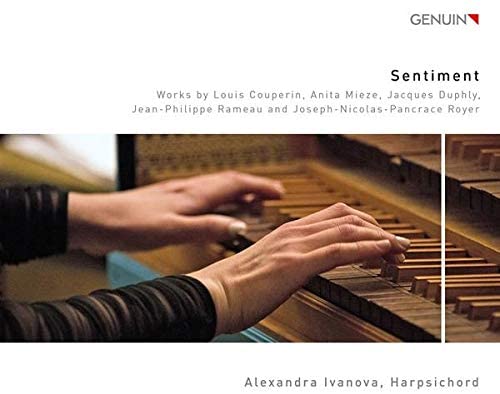Works by Louis Couperin, Duphly, Rameau, Royer & Anita Mieze (b. 1980)
Alexandra Ivanova harpsichord
82:02
Genuin classics GEN 21733
Click HERE to buy this on amazon.co.uk
[These sponsored links help the site remain alive and FREE!]
This debut recording showcases late French baroque keyboard music by Jean-Philippe Rameau, Jacques Duphly and Pancrace Royer; these are bookended with pieces by Louis Couperin and interspersed with three by the contemporary Latvian composer Anita Mieze. The Russian-born Ivanova displays an excellent feel for French styles, whether the ‘classical’ Couperin, or the more flamboyant Royer and Duphly. She has the necessary exuberance and virtuosity for Duphly’s Médée or Royer’s Tambourines but is equally impressive on the more meditative side of those composers’ work. Her inégales playing is very flexible and gives her performances a strong improvisatory feeling, as if the music was being composed as she goes along. Indeed, she prefaces Rameau’s Gavotte et six doubles with her own-composed short Prélude non mesuré. That track is particularly successful, building the sonority and excitement very well through the variations. In the more exuberant pieces, she occasionally gets a bit carried away by the excitement and rushes slightly ahead of the acoustics but, in general, these are fine performances which provide an excellent introduction to the broad sweep of French baroque music.
I was less convinced by the Mieze pieces which, despite the composer’s stated intention, only really exploit the harpsichord’s possibilities in one piece, Ansichtskarte. The other two seem rather aimless and none relate well to the structured feel of the rest of the programme. Ivanova plays the baroque music on a Joel Katzmann copy of a 1638 Ruckers, presumably with ravalement. For the contemporary pieces she uses a Blanchet copy by Titus Crijnen. It would have been interesting to have heard some of the late French pieces on the latter instrument. Both are expertly recorded here, particularly the Katzmann which has both good clarity and acoustic depth. This contributes to the success of the final track here, Louis Couperin’s Tombeau de Mr. de Blancrocher which I particularly enjoyed.
Noel O’Regan
